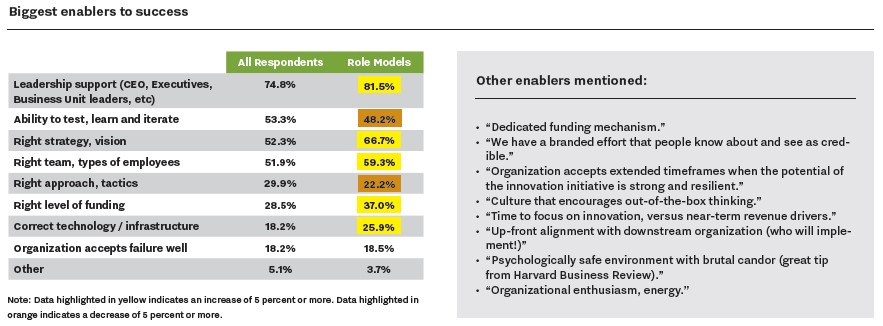Highlights (cont.)
Obstacles Observed
Trying to do something new will never be easy. Anyone that has tried to drive innovation within an organization before will surely acknowledge that. KPMG asked about the most common obstacles observed by their respondents. And that question drove home one of the starkest differences between the All Respondents group and the Role Models.
The All Respondents group noted that “Politics / Turf Wars / No Alignment” was the biggest obstacle for 51.9% of its members. Which was the highest response, followed closely by “Cultural Issues” at 47.2%. Based on those two findings, it is clear that the larger All Respondents group is largely focused on “getting the car in gear.” They are focused on getting their innovation programs in motion.
When asked whether politics and turf wars were obstacles for the Role Models group, only 25.9% responded that it was. And only 22.2% of the Role Models said cultural issues were a challenge. The biggest issue they noted? Recruiting.
The difference between the All Respondents and Role Models group shouldn’t be a surprise when you consider KPMG’s criteria for identifying the Role Models. Still, this really highlights the difference between the two groups. And hopefully offers hope that an organization can get past the initial stages of internal bickering and focus on the good of the larger organization.

Enablers to Success
To dissect the Enablers, I’m going to take a different approach. Instead of comparing the two groups, for this section, I’m going to simply focus on the Role Models. The reason being, I feel like they have a better understanding of the enablers based on where they are in the maturity of their processes.
Over the past year, the Role Models group has shown cited increased importance on Leadership support, having the right strategy/vision, having the right team and employees, having the right funding and having the correct technology/infrastructure. I was surprised to see leadership support and technology/infrastructure on this list. As leadership buy-in is obvious to me. And whenever I talk to people about Innovation Management, their first thoughts are always around technology – either directly or indirectly.
But the increased awareness towards having the right strategy and right team fall in line with other industry trends I’m seeing. It is why you are starting to see companies move away from the generic “Innovation Labs.” I feel like at the start of the last decade, companies thought if they put smart people, usually identified as scientists or engineers, in a room and left them alone that they would develop something great. It is clear now that that doesn’t work.
It’s also clear that customers need to get involved early. It’s clear that the answer is not “can we build something?” but rather “should we build something?”. And that’s why you are seeing the development of the TC 279/ISO 56000 – Innovation Management standard and groups like the International Association of Innovation Professionals begin to emerge. And if I were a betting man, I’d expect those trends to continue.
The image below shows all of the enablers identified by both the All Respondents and Role Models groups.

Show, Don’t Tell
ESPN was one of the identified Role Models. As part of their report, KPMG interviewed Ryan Spoon, a Senior VP of Digital and Social Media for the Worldwide Sports leaders. The best advice that he provides, is that when asking for money, show a working prototype.
It’s much harder to [get budget approvals] when the ask is coming from a PowerPoint deck — as opposed to some examples of success you’ve already demonstrated. It’s also easier to [allocate resources] once you know there’s an audience there.
Ryan Spoon, ESPN
I could not agree more.